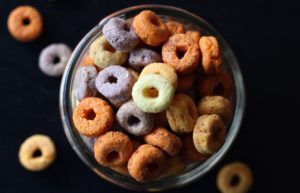Food Coloring Sensitivity Symptoms: Could This Be Your Child?
Could your child’s physical, mental, behavioral and emotional symptoms be connected to food colorings and dyes added to processed foods that are a part of your diet. Typically, these children start showing symptoms around age 1 when foods are being introduced into the diet.
Years later and many medications later parents are struggling to figure out what is causing all these issues.
Food dyes and colorings has been a controversial subject since pediatrician, Dr. Benjamin Feingold published his findings in the 19070’s and noted the link between hyperactive behavior and dyes. But scientists and the government are not in consensus. Some studies do not state that these dyes cause behavioral issues but do state that dyes may contribute to making ADHD symptoms worse.
In 2004, the results from 15 studies concluded there was a modest worsening of behavior when children with ADHD consumed foods with synthetic dyes. Since then the European Union commissioned 2 studies to clarify the situation. The results were convincing enough that the European Union passed a law requiring a warning on foods that contain one or more of the suspicious dyes.
What did the U.S. do? They decided it is up to our government to decide when these dyes cause harmful effects. Thus, our products carry no warning label for parents. For some children, they may be extra sensitive to even very small amounts of dyes and colorings.
As a parent, you know your child best. If 8 or more symptoms below sound like your child, try a 2- week elimination of all dyes and colorings from your child’s diet. The worst thing that can happen is that your child will eat a healthy nutritious diet for 2 whole weeks minus many of the processed junk food on today’s shelves.
Food Dyes
- Red 40 (this has been associated with aggressiveness and impulsive behavior in children, hitting, biting, kicking, tantrums)
- Yellow 5 (most often associated with insomnia, hyperactivity and learning disabilities)
- Yellow 6
- Red 3
- Blue 1
- Blue 2
- Green 3
- Annatto (a natural food coloring)
- Carmine (a natural food coloring)
Signs Your Child’s Behavior Could Be Related to Dyes/Colorings
- Hyperactivity (the H in ADHD)
- ADD symptoms (inability to focus, inattention)
- Sleep issues
- Mood swings (can be in a span of one day, several hours…)
- Violence, aggression (i.e.: in kids; spitting, biting, kicking, growling, tantrums that can last an hour or longer)
- Lack of impulse control (disruptive, interrupts when someone is speaking, excessive talking, difficulty in transitioning from one task, one activity to another)
- Headaches, stomachaches, vomiting
- Bed wetting, well past toilet trained age
- Skin ailments such as eczema, hives, unexplained rashes
- Breathing issues such as asthma
- Compulsive: picks at his or her skin, repeats certain actions, pulls out his or her own hair, or eyebrows.
- Not consistent: for instance, you think it could be due to sugar, but one day he eats sugar and he is fine and another day he eats a sugary food and he is off the wall with his behavior. In this case, it may not be the sugar!
- Headbanging as a toddler, typically started when foods were introduced into the diet when an infant or toddler. Headbanging typically stops around age 3 once the child is larger with more weight on his body to “handle” the amounts of dyes in foods.
- Has a diagnosis of Sensory Processing Disorder
- Sensitive to bright lights, loud noises.
- Frequent bouts of crying
- Sensitivity can continue into adulthood and can be a cause for anger, depression and aggression
If you identify with one to three or four items on this list, it may not be a dye/coloring root cause. Still it cannot hurt to remove dyes and colorings from the diet for 2 weeks to note any changes. Most children that have a dye/coloring reaction identify with 8 or more on this list.
The Good News
Manufacturers are listening to parents. Many have removed or are in the planning stages of removing dyes from their products. Kraft has removed dyes from some, not all, of their products. General Mills has removed dyes from Trix and Yoplait go-gurts. Chick-fil-A removed yellow #5 from its chicken soup, Frito lay has removed dyes from Lay’s seasoned and kettle cooked chips, Sun Chips and Tostitos, and Pepperidge Farm removed dyes from Goldfish Crackers. Please note that Goldfish contain annatto which is a natural food coloring and some children are sensitive to this.
What to Do If You Suspect a Food Dye/Coloring Reaction in Your Child?
The first thing to do is to start clearing out your home of all foods that contain dyes and colors. This is a big task as it will require you to read labels on everything. Dyes and coloring are added to foods you would not think of such as your jar of pickles. Some more obvious foods include cereals, processed American cheese and colored beverages. It is not just in that rainbow-colored cupcake icing, m and m’s, skittles or starbursts but it can be hidden in salad dressings, crackers, chips, soups and much more.
Once you have cleaned out your pantry, then it is time to shop. Go when you know you have the time to read labels and plan for more than an hour in the store. Once you get the hang of products that are safe and your child likes, the process will become easier.
Your child can also react to food dyes in toothpaste, vitamins and medications! Don’t forget to check these products too.
What ends up happening is that these children exceed the safety limit due to overconsumption of foods with dyes and colorings.
If you do not see any significant positive changes within the 2 weeks, this may not be the root cause. If this symptom list still sounds like your child, you may want to then explore a preservative free diet and look for labels that contain sodium benzoate (to start) which has been linked to hyperactivity in children.
Is It Impacting Your Child’s Gut Health?
Unfortunately, I cannot find any direct links or studies showing that a sensitivity to artificial dyes and colorings could impact gut health. However, just because the information is not out there, does not mean it does not exist. If food sensitivities, such as one to dairy or gluten can cause leaky gut syndrome then at this point I must believe that a dye sensitivity can do the same.
What this means is that once you remove these suspected foods and have a routine with your new diet, the next step is to address gut healing. I like to do this with a product called Restore along with fermented foods and other targeted supplements if necessary.
What to Do Next
If removing artificial and natural colorings did not help, don’t give up. Slowly remove other additives, removing only one at a time such as:
- Benzoates (in juices, soft drinks, syrups, meds)
- Sorbates (in margarine, dips, cakes, fruit products)
- Sulphites (in dried fruits, fruit drinks, sausages and more)
- Nitrates (processed meat products)
- Propionates
- Flavor enhancers (MSG 621 and others in the 600 range)
For a more complete list of possible additives that your child may be reacting to, go to fedup.com.au and use that as a good resource to guide you.
Bottom Line: Your child does not have to suffer. Work with a holistic nutrition professional to help you figure out the root cause for your child’s behavioral, mental and emotional issues.
Did removing dyes from your child’s diet make a difference? If so I would love to hear from you!
Sources
- https://www.scientificamerican.com/articles/does-artificial-food-coloring-contribute-to-adhd-in-children/
- http://articles.mercola.com/sites/articles/archive/2014/05/22/artificial-food-dyes.aspx
- https://www.ncbi.nlm.nih.gov/pmc/articles/PMC3441937/
- http://www.huffingtonpost.com/laurie-david/post_1891_b_843577.html
- http://www.fedup.com.au/factsheets/symptom-factsheets/head-banging
- http://www.happymothering.com/02/health-2/nutrition-health-2/beyond-allergies-why-food-dyes-may-cause-child-behavioral-problems/
- https://cspinet.org/eating-healthy/ingredients-concern/food-dyes/testimonies
- Dorfman, K. (2013) Cure Your Child with Food. NY: Workman Publishing Group




I spent a lot of time to find something like this
I spent a lot of time to find something like this
Removal and d dyes and other petroleum based additives/preservatives has made a huge difference in my son. His behavior and ability to learn has significantly improved. In addition many of his sensory issues (SPD) have improved or gone away.
Removal and d dyes and other petroleum based additives/preservatives has made a huge difference in my son. His behavior and ability to learn has significantly improved. In addition many of his sensory issues (SPD) have improved or gone away.
So glad to hear that you were able to figure out that dyes and colorings were impacting your son’s health and that he is doing much better!
So glad to hear that you were able to figure out that dyes and colorings were impacting your son’s health and that he is doing much better!
My 8 year old son was on a downhill slide behavior wise and was so negative, sad and his view of himself and others was getting worse every day. I had no idea what to do. Then, after an hour and a half of prayer for my son, God showed me the cause: it was the flinstone vitamins I’ve been giving him everyday for months… as I gave more thought to it I realized that since he was almost two he would have behavior changes after eating sugar, I always thought it was the sugar- never occurred to me it could be dye. So we are on day 3. Yesterday his class had a read around America celebration which included a bunch of “food” with dye and he was out of control for the rest of the afternoon. So sad but also great confirmation. I’m so grateful to God for showing me what was going on- it could have gone so many other ways. Glory to Him!
My 8 year old son was on a downhill slide behavior wise and was so negative, sad and his view of himself and others was getting worse every day. I had no idea what to do. Then, after an hour and a half of prayer for my son, God showed me the cause: it was the flinstone vitamins I’ve been giving him everyday for months… as I gave more thought to it I realized that since he was almost two he would have behavior changes after eating sugar, I always thought it was the sugar- never occurred to me it could be dye. So we are on day 3. Yesterday his class had a read around America celebration which included a bunch of “food” with dye and he was out of control for the rest of the afternoon. So sad but also great confirmation. I’m so grateful to God for showing me what was going on- it could have gone so many other ways. Glory to Him!